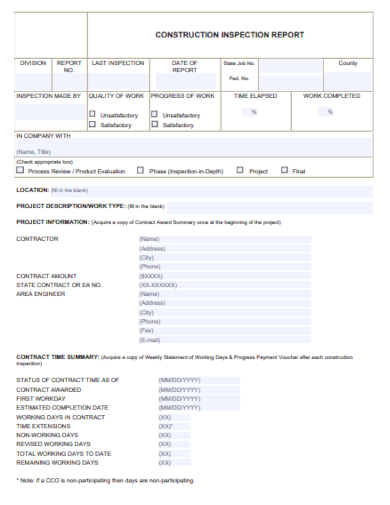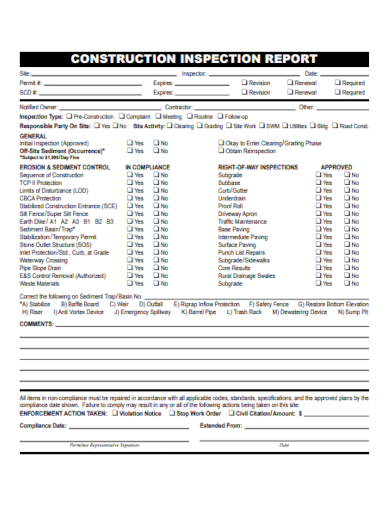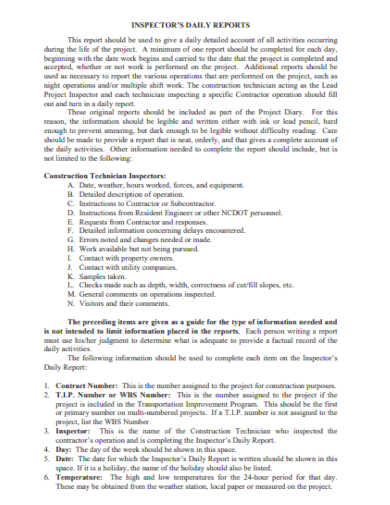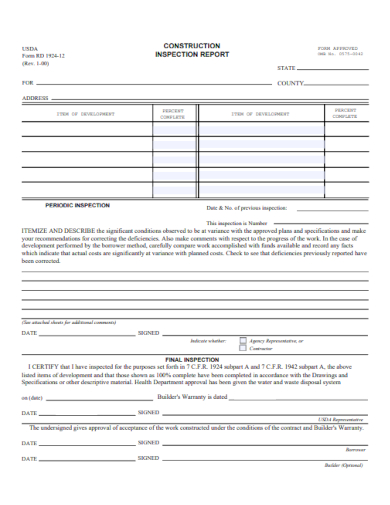25+ SAMPLE Construction Inspection Report
-

Construction Inspection Report Template
download now -

Construction Daily Inspection Report Template
download now -

Construction Final Inspection Report Template
download now -

Restaurant Inspection Report Template
download now -

Buyer’s Property Inspection Report Template
download now -

Daily Construction Jobsite Inspection Report
download now -

Daily Construction Inspection Report
download now -

Weekly Construction Inspection Report
download now -

Construction Site Inspection Visit Report
download now -

Monthly Construction Inspection Report
download now -

Construction Inspection Report Format
download now -

Sample Construction Inspection Report
download now -

Construction Site Inspection Report
download now -

Construction Inspector Daily Report
download now -

Post Construction Inspection Report
download now -

Construction Inspection Report in PDF
download now -

Environmental Construction Inspection Report
download now -

Construction Progress Inspection Report
download now -

Engineer Construction Inspection Report
download now -

Construction Company Inspection Report
download now -

Construction Cleaning Inspection Report
download now -

Building Construction Inspection Report
download now -

Construction Inspection Report Form
download now -

Construction Contractor Inspection Report
download now -

Construction Field Inspection Report
download now -

School Construction Inspection Report
download now
FREE Construction Inspection Report s to Download
25+ SAMPLE Construction Inspection Report
Definition:
The Importance of Construction Inspection Reports:
Understanding the Basics:
Key Components of an Effective Inspection Report:
Leveraging the Report for Continuous Improvement:
Incorporating Technology for Enhanced Reporting:
The Role of Stakeholders in Inspection Reports:
Regular Updates and Follow-Ups:
Training and Skill Development:
Benefits Beyond the Construction Phase:
How frequently should a construction inspection report be conducted and documented?
Are subcontractor activities and installations covered in the inspection report?
Why should a construction inspection report be kept archived for future references?
What safety measures are typically assessed in a construction inspection report?
When do construction site inspections become more critical in the project timeline?
Definition:
A Construction Inspection Report is a comprehensive document that details the conditions, standards, and quality of construction activities at various stages. It is produced by qualified inspectors who assess and record the project’s adherence to design specifications, building codes, and other industry standards, ensuring safety, compliance, and optimal work quality throughout the construction lifecycle.
The Importance of Construction Inspection Reports:
Delving into the world of construction projects, the Construction Inspection Report stands out as an essential tool for ensuring quality, safety, and compliance. Serving as a project’s safeguard, this report acts as both a monitor and guide. Let’s explore its significance and delve into its intricate details.
Understanding the Basics:
Every construction project, regardless of its size, requires meticulous planning, execution, and monitoring. The Construction Inspection Report is instrumental in capturing the essence of the latter.
Key Components of an Effective Inspection Report:
- Introduction and Overview: This section provides a brief summary of the project, the purpose of the inspection, and the date and time it took place.
- Inspector Details: Includes the name, qualifications, and contact information of the inspector. This validates the credentials of the individual responsible for the findings.
- Site Details: A description of the construction site, its location, and the specific areas inspected.
- Work Progress Summary: An outline of the progress made since the last inspection. This gives context to the inspection, indicating what new elements were under scrutiny.
- Observations and Findings: A detailed list of observations, both positive and concerning. This section is often structured with bullet points or numbered lists for clarity.
- Photographic Evidence: Images taken during the inspection that highlight particular areas of interest or concern. These provide visual proof of the written observations.
- Non-compliance Issues: Specific areas or practices that don’t adhere to the required standards, codes, or project specifications.
- Recommendations and Corrective Actions: Suggestions or mandatory actions to address the issues identified. This section provides a roadmap for the project team to rectify concerns.
- Approval/Rejection Status: Clearly indicates whether inspected work is approved or rejected, often with an accompanying reason for the decision.
- Follow-up Notes: Information about any required follow-up inspections, especially if particular issues need re-examination after corrective measures are taken.
- Signature and Date: The inspector’s signature validates the report, and the date provides a clear timeline for when observations were made.
Leveraging the Report for Continuous Improvement:
Embracing Feedback:
Actively using the inspection report’s feedback can guide modifications, ensuring subsequent phases of the project are more efficient and compliant.
Data-Driven Decisions:
Quantitative findings in the report provide a basis for making informed decisions, reducing guesswork and streamlining project management processes.
Safety Enhancements:
By addressing noted safety concerns, future risks are mitigated, fostering a safer work environment and reducing potential liabilities.
Quality Assurance:
Regularly reviewing and acting upon inspection findings guarantees adherence to standards, which in turn enhances the overall quality of the construction.
Cost-Efficiency Realization:
Identifying and rectifying issues early on, as highlighted in reports, can lead to significant cost savings, preventing more expensive adjustments in the later stages of a project.
Stakeholder Confidence:
Demonstrating a commitment to continuous improvement through the consistent use of inspection reports can bolster stakeholder confidence in the project’s management and execution.
Incorporating Technology for Enhanced Reporting:
Digital tools and software are revolutionizing how Construction Inspection Reports are created and shared. Integrating technology not only speeds up the process but also enhances the report’s accuracy.
Digital Inspection Tools:
Utilizing advanced tools like drones or infrared cameras can provide comprehensive visuals of hard-to-reach areas, ensuring no oversight in inspection.
Real-time Data Collection:
Leveraging mobile apps and cloud-based platforms allows inspectors to input findings directly on-site, reducing delays and potential data entry errors.
Integration with Management Software:
Synchronizing inspection reports with construction management software ensures seamless tracking, real-time updates, and facilitates timely decision-making.
Use of AI and Machine Learning:
Implementing AI can help in analyzing patterns from past inspections, predicting potential future issues, and offering preventive solutions.
Automated Alerts and Notifications:
Digital platforms can automatically alert relevant parties of critical findings or non-compliances, ensuring immediate action and minimizing project disruptions.
Data Visualization:
Advanced software can transform raw inspection data into interactive visual dashboards, aiding in easier interpretation and more effective presentations to stakeholders.
The Role of Stakeholders in Inspection Reports:
Every construction project involves a myriad of stakeholders, from architects and designers to contractors and end-users. A robust Construction Inspection Report bridges the information gap among these parties.
Importance of Stakeholder Engagement:
Stakeholders play a pivotal role in shaping inspection reports as they provide valuable input, ensuring reports cater to their specific needs and address concerns related to the construction project.
Client or Investor Insights:
Clients or investors typically have financial stakes in the project. Their feedback ensures the inspection aligns with their investment objectives, ensuring transparency and fostering trust.
Insights from On-Site Workers:
Workers offer a hands-on perspective, highlighting practical challenges, safety hazards, or areas needing improvement that might be missed otherwise.
Feedback from Project Managers:
Project managers provide a holistic view of the project’s progress and potential roadblocks. Their input ensures the inspection report aligns with the project’s broader objectives.
Suppliers and Material Providers:
They offer insights into material quality, ensuring the inspection report addresses any potential issues or discrepancies in supplied materials.
Local Community Feedback:
Insights from the local community can highlight environmental or societal impacts, ensuring the construction project remains sustainable and socially responsible.
Continuous Collaboration and Communication:
Regular interaction between stakeholders and the inspection team fosters a collaborative environment, enhancing the report’s quality and ensuring all concerns are addressed.
Regular Updates and Follow-Ups:
For the Construction Inspection Report to be effective, it should not be a one-time document but rather an ongoing record.
The Imperative of Regular Reporting:
Providing consistent updates and conducting periodic follow-ups ensure that all stakeholders stay informed about the construction project’s progress, challenges, and milestones achieved.
Immediate Action on Findings:
Regular updates allow for prompt action on inspection findings, ensuring any issues or discrepancies are addressed in real-time, minimizing delays or cost overruns.
Building Stakeholder Trust:
Transparent and consistent communication strengthens the bond of trust between stakeholders, the construction team, and inspection authorities.
Tracking and Monitoring Progress:
Consistent updates enable stakeholders to monitor the construction project’s pace, ensuring it aligns with predefined timelines and objectives.
Facilitating Decision Making:
Regular updates provide decision-makers with up-to-date information, facilitating informed and strategic choices related to the project.
Ensuring Compliance and Adherence:
Consistent reporting ensures that the construction project remains compliant with regulations, safety standards, and contractual obligations. Follow-ups ensure that any deviations are corrected in a timely manner.
Encouraging Accountability:
When inspection teams know that regular updates and follow-ups are expected, it fosters a sense of responsibility and commitment, ensuring meticulous inspections and comprehensive reporting.
Building a Repository:
Consistent updates contribute to building a detailed record or repository of the construction project’s journey. This can serve as a valuable reference for future projects or audits.
Training and Skill Development:
While technology can offer tools, the quality of a Construction Inspection Report largely depends on the skills of the inspector.
Importance of Training for Construction Inspection:
Training equips inspectors with the necessary skills to identify and report potential issues, ensuring projects meet industry standards and safety regulations.
Tailored Skill Development Modules:
Customized training modules ensure that inspectors are equipped with the specific knowledge needed for diverse construction projects.
Feedback and Performance Reviews:
Regular reviews provide inspectors with constructive feedback, highlighting areas for improvement and ensuring consistent quality in reports.
Incorporating Technology in Training:
Modern training methods integrate technology, like augmented reality, to provide hands-on learning experiences, enhancing the inspection process.
Collaborative Learning Sessions:
Group training encourages knowledge sharing, promoting a holistic learning environment where inspectors can learn from peers’ experiences.
Future-Ready Skill Sets:
With the construction industry evolving, training must encompass futuristic skills, preparing inspectors for upcoming challenges and innovations.
Benefits Beyond the Construction Phase:
The utility of a Construction Inspection Report extends beyond the construction phase. These reports can be invaluable during the building’s maintenance phase.
Paving the Way for Future Projects:
A well-documented inspection report serves as a blueprint for subsequent construction ventures, offering insights into best practices and areas of improvement.
Liability and Dispute Resolution:
Having a detailed record can aid in resolving disputes or claims made post-construction. The report provides an objective account of events, materials used, and processes followed.
Enhancing Reputation and Credibility:
Companies that maintain comprehensive inspection reports are perceived as transparent, accountable, and professional, enhancing their credibility in the market.
Maintenance and Upkeep:
The report serves as a reference point for future maintenance, highlighting potential areas of wear and tear or detailing the materials used, which can guide maintenance crews.
Resource Planning:
Future projects can leverage the insights from the report to allocate resources more effectively, plan budgets, or determine timelines based on previous experiences.
Knowledge Transfer:
For companies with a rotating workforce, inspection reports become vital tools for knowledge transfer, ensuring new members are quickly brought up to speed with past projects.
Quality Assurance:
Inspection reports play a pivotal role in quality checks even after project completion, ensuring the constructed entity meets the promised standards and specifications.
Investment and Funding:
For construction companies seeking additional investments or funding for future projects, a detailed inspection report serves as proof of their commitment to quality, efficiency, and regulatory compliance.
How frequently should a construction inspection report be conducted and documented?
Construction inspection reports should be conducted regularly based on project milestones, critical tasks, and phases to ensure consistent quality and safety. Typically, inspections occur weekly or bi-weekly, but they might be more frequent for complex or high-risk tasks. Proper documentation post-inspection ensures timely intervention and adherence to standards.
Are subcontractor activities and installations covered in the inspection report?
Yes, subcontractor activities and installations are integral parts of the construction inspection report. It ensures that all work, regardless of who performed it, meets project specifications, quality standards, and safety regulations. Monitoring subcontractors through inspection reports helps maintain consistent quality and accountability throughout the construction project.
Why should a construction inspection report be kept archived for future references?
Archiving construction inspection reports is essential for future references because they serve as valuable historical records. These reports provide a comprehensive account of the construction project’s progress, quality standards, and compliance with regulations. They aid in audits, dispute resolution, future project planning, and knowledge transfer to enhance efficiency and accountability.
What safety measures are typically assessed in a construction inspection report?
A construction inspection report assesses various safety measures, including the proper use of personal protective equipment (PPE), adherence to safety protocols, fall protection measures, hazard identification and mitigation, equipment safety checks, fire safety compliance, and overall compliance with safety regulations to ensure a safe work environment.
When do construction site inspections become more critical in the project timeline?
Construction site inspections become increasingly critical as the project progresses through key milestones and phases, such as foundation work, structural framing, electrical and plumbing installations, and final finishes. These inspections ensure that critical structural and safety elements are correctly implemented before proceeding to the next phase, minimizing errors and rework.
In conclusion, the Construction Inspection Report remains paramount in safeguarding project quality and adherence to standards. As a beacon for transparency and trustworthiness, it reinforces stakeholder confidence, ensuring that every phase aligns with best practices. Leveraging this report, construction professionals can optimize processes, ensuring project excellence from inception to completion.
